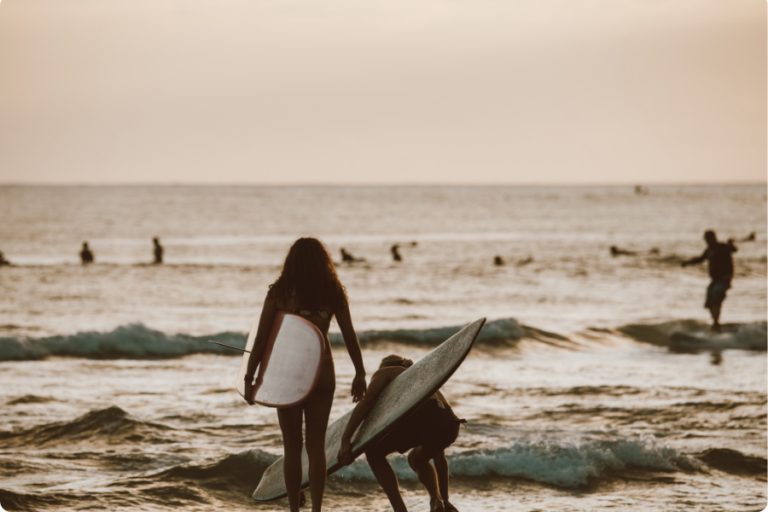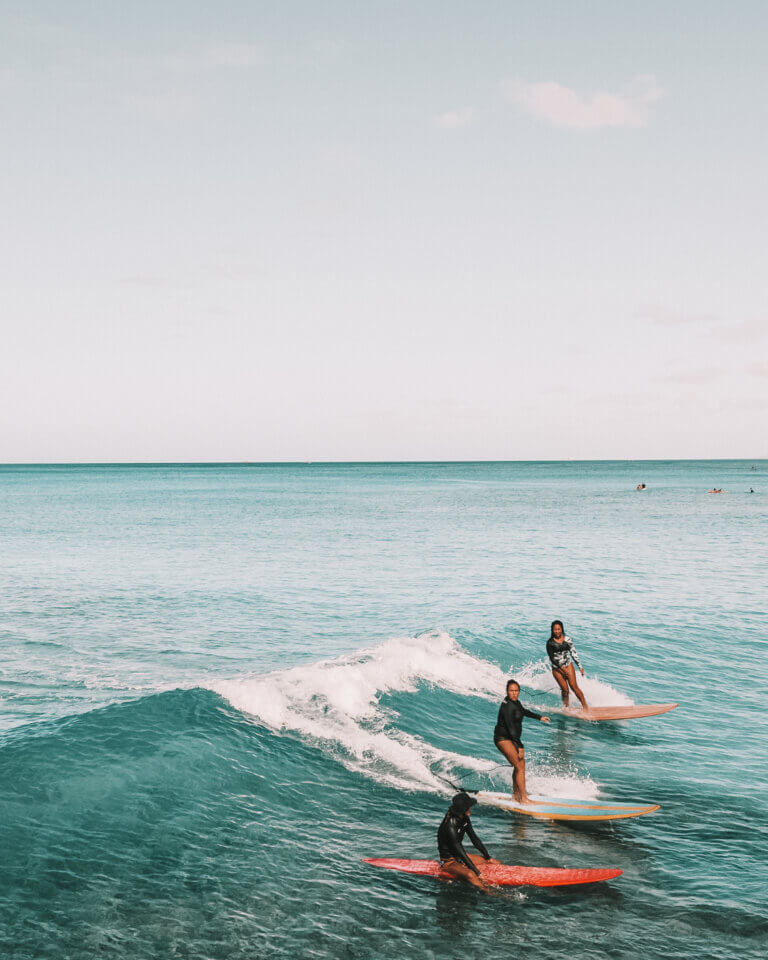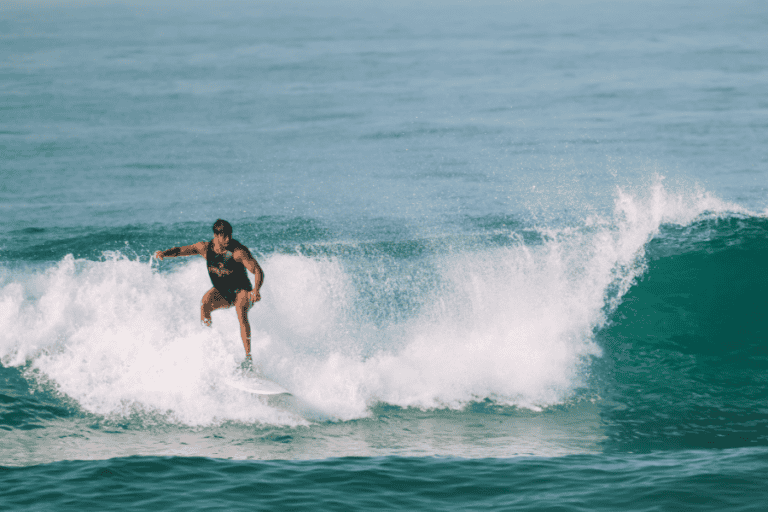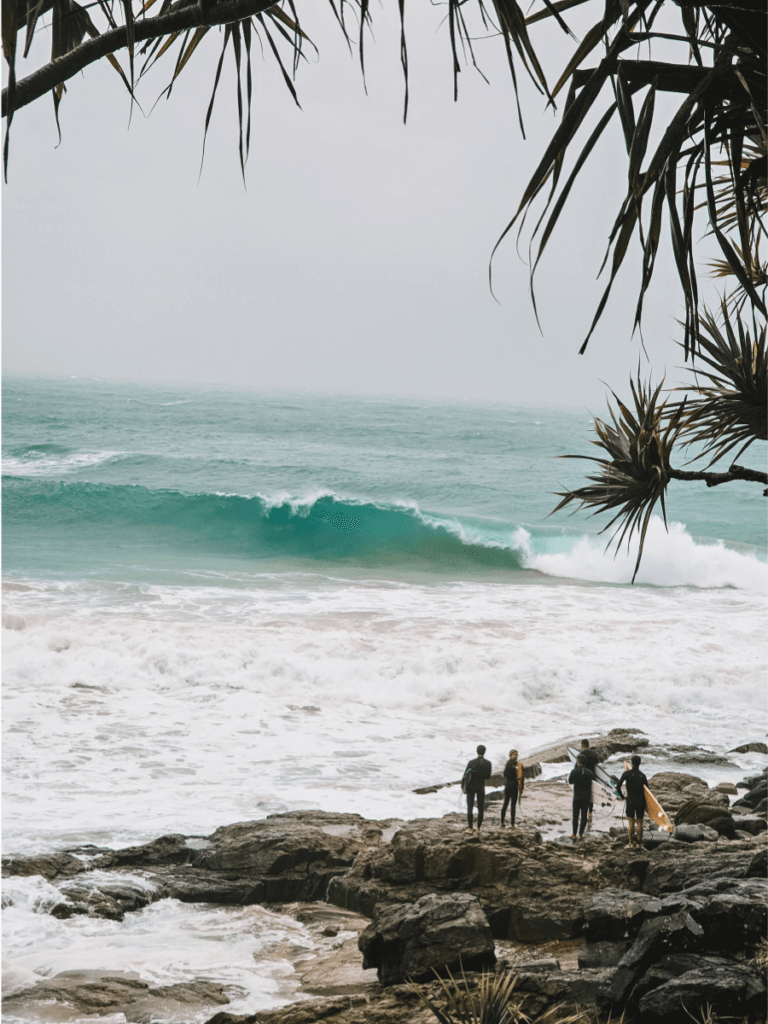5 Surfing Tips for Beginners: What Every Surf Newbie Should Know Before Hitting the Waves
In this post, you’ll discover the 5 most important surfing tips for beginners – even before stepping on a surfboard for the first time!

When I started surfing, I had no idea how complex it really is. Since surfers mostly look so relaxed, having that laid-back attitude, it’s easy to underestimate how much goes on behind the scenes. But that’s exactly what made me fall even more in love with this sport!
Especially at the start, surf beginners can make plenty of mistakes that lead to frustration, injuries, conflicts with other surfers, or slower progress. That’s why it’s crucial to be aware of certain things and have some basic knowledge before you even set a foot in the water.
The following surfing tips for beginners will help you celebrate your first successes and give you the perfect start to your surfing journey. Warning: surfing can be highly addictive!
In this post, I’ll share my top surfing tips for beginners to ensure your introduction to surfing is smooth and enjoyable.
5 Best Surfing Tips for Beginners
1. Choose a Beginner-Friendly Surf Spot!
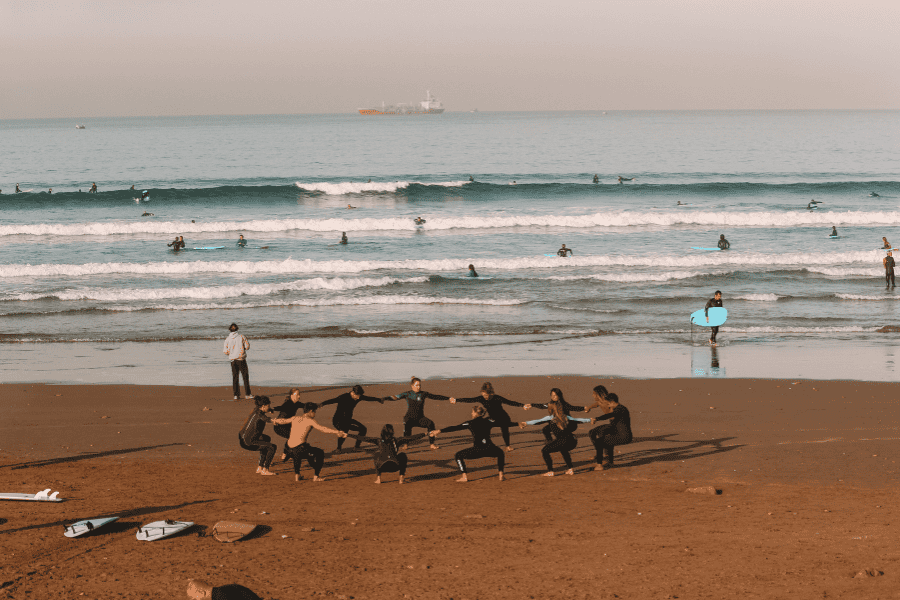
Not every surf spot is suitable for surf beginners and not every spot is beginner-friendly on every day! Confused? That’s completely normal! It’s important to research potential locations in advance, familiarize yourself with the surroundings, and avoid booking trips blindly. Choosing the wrong spot can make a big difference to how much fun you’ll have and can even be dangerous if you make the wrong decision. I’ll go into this in more detail in the second point, but get help from a local surf instructor here!
How to Identify a Beginner-Friendly Surf Spot?
- Beach Breaks: A sandy bottom is ideal for learning. It minimizes injuries from falls and makes practicing easier, especially with whitewater waves. Beach breaks also allow you to gradually venture into the line-up as you gain confidence.
- Small Waves: Look for small, gentle waves as a beginner. Waves around 1–3 feet (approx. 0.3–0.9 meters) provide the perfect playground. Make sure the waves break slowly and roll softly. Long stretches of whitewater are great for practicing balance.
- Minimal Currents: Some spots have strong currents that are hard to detect as a beginner. Strong currents can be dangerous, especially for new surfers. Always talk to local surfers about the spot – or better yet, consult a surf instructor.
- Fewer Crowds: Crowded spots increase the risk of collisions. Find an area with plenty of space between surfers.
- Presence of Surf Schools: Locations with many surf camps and schools are often a good indicator of beginner-friendly spots.
Popular beginner spots include Canggu & Kuta in Bali, Weligama in Sri Lanka, and southern France or Portugal in summer.
pssst…
(Read here about my favourite Beginner Surf Spots during the winter months!)
“I’m Already an Intermediate – Which Surf Spot is Right for Me?”
Intermediate surfers can also benefit from beach breaks – as long as the waves pack a bit more power. Waves between 3 and 5 feet (approx. 0.9 to 1.5 meters) are ideal for honing your skills. Look for clean wave shoulders where you can practice riding parallel and try your first maneuvers.
Point breaks are also excellent for intermediates. Since you’re already more confident in the water, you can take advantage of their predictable waves and long rides, giving you plenty of time to refine your technique.
You’ll find great Intermediate-friendly Spots around the world like Surf Spots in Bali (e.g., Canggu), Costa Rica (e.g., Santa Teresa), Portugal (e.g., Ericeira), and Fuerteventura. These spots offer ideal conditions to take your surfing to the next level!
2. Choose the Right Surfboard!

Choosing the right surfboard is crucial to how quickly you’ll progress, because the right surfboard for you can make the difference between practicing on a single wave or fifteen waves in one session! That makes it one of the most important surfing tips for beginners. When you start surfing, you want to use a surfboard that has a lot of volume, i.e. a lot of buoyancy. As a surf newbie, you’ll start with a softboard or soft-top surfboard. These boards are partially made of foam, providing more buoyancy and making them more durable and resilient than other materials.
Your board should be appropriately sized for your height and weight, with enough volume. A length of about 7’2 to 8’2 feet, depending on your size and weight, is ideal. A voluminous board offers better stability and makes taking off easier, which is why it’s perfect for beginners.
Unfortunately, I often see many surf beginners choosing the wrong board or switching to a smaller one too quickly—whether out of impatience, lack of knowledge, or misplaced ego! Don’t be one of them! Also, avoid starting with a longboard. It’s not suitable for beginners. I’ll cover this topic in another article (psst… sign up for the newsletter to stay in the loop!).
3. Learn to Surf with a Surf Instructor!

I know that nowadays, with easy access to knowledge through Youtube, Google & Co., you can teach yourself almost anything: languages, musical instruments, technologies – no problem. Many sports can also be learned on your own. But surfing is different. It’s not without reason that it’s considered one of the toughest sports in the world.
Of course, you can grab a surfboard and splash around in the water, but that has little to do with actual surfing – and it can even be life-threatening. If you’re serious about this incredible sport, make sure to start with a surf instructor.
A great way to begin is in a surf camp, where you usually get input throughout the day and can fully focus on learning to surf. I learned to surf at the KIMA Surf Camp in Bali, and it was such an amazing experience that I recommend starting out at a camp to everyone. However, if you prefer to book your own accommodation, a surf school or private Coach is also a fantastic option!
What are the benefits of starting with a Surf Instructor?
- Faster Progress: With an experienced instructor by your side, you’ll learn the basics like paddling, popping up, and reading waves much faster and more efficiently. They’ll show you exactly how to position yourself correctly on the board and how to move safely in the water.
- Avoiding Mistakes: Many beginners make small mistakes that can be hard to correct later – whether it’s poor posture, bad timing, or inefficient paddling. An instructor will spot these immediately and ensure you’re practicing correctly from the start.
- Safety: As beautiful as the ocean is, it’s a powerful force of nature. Currents, sharp underwater terrain, or unpredictable conditions can be dangerous. An experienced instructor understands the local conditions, explains potential hazards, and ensures you’re surfing in a safe area.
- Respect in the Water: Experienced surfers appreciate when beginners approach the sport with respect and learn it the right way from the ground up. This includes understanding the surfing rules – the so-called surf etiquette. An instructor will teach you these rules, allowing you to confidently and respectfully join the surf community from the beginning.
- A Solid Foundation: A good start determines how much enjoyment you’ll have with surfing in the long term. An instructor provides you with the essential knowledge and skills to continue learning with confidence and to steadily improve.
4. Be Prepared!

Surfing is a demanding sport with unfamiliar movements, requiring strength and endurance. Even athletic individuals can quickly reach their limits, as they might not have trained the specific muscles needed for surfing. That’s why incorporating fitness into your preparation is one of the most valuable surfing tips for beginners.
To fully enjoy your surf trip, it’s essential to build a basic level of fitness. If you start incorporating the following exercises at least three months before your trip, I promise, you’ll notice a significant difference:
- Upper Body Training! Many struggle with paddling due to a lack of arm, back, and shoulder strength – all crucial for surfing. The best exercise, of course, is paddling itself, which you can practice on a lake if you have access to a surfboard. Alternatively, swimming, especially freestyle, is excellent preparation. Strength exercises like push-ups (at least ten clean repetitions) and pull-ups are also great. (If you’re a woman struggling with pull-ups, don’t get discouraged – I can’t do them either, and I manage just fine!)
- Endurance Training! The better your stamina, the longer you can practice! If you’re exhausted after 30 minutes in the water, you’ll have less time to internalize the basics. Aim for a two-hour session. Interval training is particularly effective – a tip shared by experienced coaches!
- Mobility & Balance : Surfers need flexible joints to execute precise movements and good balance to stand confidently on the board. The more mobile you are, the easier these motions will feel. That’s why yoga is so popular among surfers: it combines strength, balance, mobility, and meditation exercises – the perfect preparation for your surf trip!
- Skateboarding! Board sports like skateboarding, longboarding, or snowboarding improve your board feel and train the necessary muscles. While not identical to surfing, they can significantly ease your entry into the sport!
pssst.
Looking for inspiration to build strength and endurance? The book Fit to Surf: The Surfer’s Guide to Strength and Conditioning offers plenty of useful tips for surf preparation!
Surf Theory is equally important!
Good preparation also includes basic knowledge. Most importantly, you should understand the surf etiquette, or ask your surf guide to explain it. As a beginner, it’s crucial to learn the fundamental rules to ensure your safety in the water:
- One surfer per wave: The surfer closest to the peak has the right of way. (As a beginner, you’ll mostly surf whitewater, so there’s no “peak” – just keep a safe distance from others.)
- Give others space: Always paddle and move outside the path of other surfers riding waves. Never linger in the way.
- Hold your board tightly: Always maintain control of your board, as your leash and board create a wide radius that could harm others in the water.
- Communicate: Talk to others in the water, especially when it’s crowded. This way, everyone has more fun.
5. Have the Right Mindset!
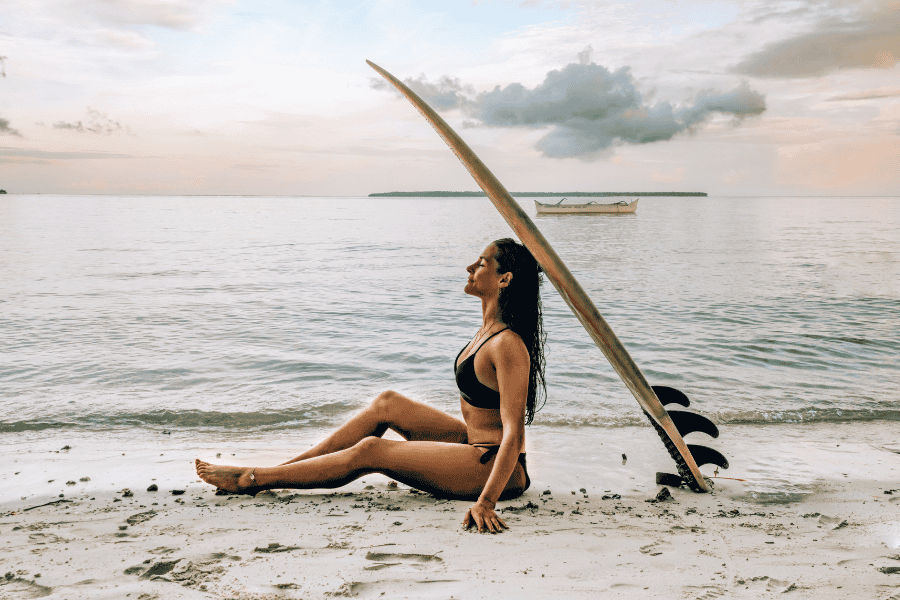
Surfing is arguably one of the most wonderful activities out there. The feeling of being in the ocean and riding a wave is truly unique and almost impossible to put into words. One thing is certain, though: learning to surf is challenging and requires a lot of effort and perseverance. While you often make constant progress very quickly in other sports, surfing is different due to the numerous external factors, such as wave conditions or the crowd factor.
It’s completely normal for every surfer – especially those who didn’t grow up with a board under their feet – to reach a point where doubts arise. Maybe you’ll think you lack the necessary talent? Forget about that! You don’t need to be born with talent to learn surfing. Everyone can do it! Truly everyone. Trust the process!
Celebrate even the smallest progress, because every step counts. Don’t get discouraged if the next success takes a little longer to come. Surfing isn’t just about riding waves – it’s about appreciating this unique activity, connecting with nature, and enjoying the privilege of being in the water. When looking for surfing tips for beginners, remember that patience and positivity are just as important as technique.
The most important thing: Have fun! Surfing should bring you joy. The more you embrace it, the more you’ll experience the beauty of the moment.
The best way to learn Surfing? Surfing!
Make sure you spend as much time in the water as possible. That means: if you wait a whole year to get back on the board after a one-week surf course, your progress will feel much slower, and you’ll often take big steps backward. Remember, it’s like learning a language – especially in the beginning, regular practice is key to making everything second nature.
Summary
Starting your surfing journey can feel overwhelming, but with the right preparation, mindset, and approach, nothing will stand in the way of your success. With the right attitude, some basic knowledge, and an experienced surf instuctor, you’ll make quick progress during your first sessions. Stay consistent and take every opportunity to practice. Even if you’re landlocked far from the waves, keep training!
Learning to surf takes dedication and persistence. But the beauty of standing on a wave and the thrill of even the smallest progress make every bit of effort worth it. Promise!
In this article, you’ve learned my top 5 tips for beginner surfers – the essentials you should know before heading into the water for the first time!

